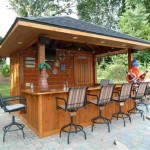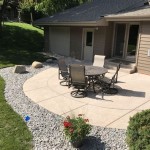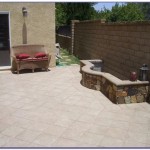Turning Your Backyard Into a Patio Paradise
Transforming an ordinary backyard into a captivating patio paradise is a rewarding endeavor. It involves careful planning, thoughtful design considerations, and a commitment to creating an outdoor space that reflects individual preferences and enhances lifestyle. While the initial investment can seem significant, the long-term benefits of increased property value, enhanced relaxation, and expanded entertaining opportunities make it a worthwhile project. A well-designed patio extends the living space of a home, blurring the lines between indoors and outdoors and offering a versatile area for various activities.
Achieving a truly exceptional patio requires more than simply laying down some paving stones and adding a few chairs. It demands a holistic approach, encompassing site assessment, material selection, landscaping integration, and the incorporation of features that contribute to both functionality and aesthetics. The goal is to craft an environment that is not only visually appealing but also practical, comfortable, and conducive to relaxation and enjoyment.
The process begins with a thorough evaluation of the existing backyard space. Factors such as sunlight exposure, drainage patterns, prevailing winds, and existing vegetation should be carefully considered. Understanding these elements will inform the design process and help to avoid potential problems down the line. For example, a patio placed in an area with excessive sunlight exposure may require the addition of shade structures, while a poorly drained area might necessitate the installation of a drainage system.
The size and shape of the patio will largely be dictated by the available space and the intended use of the area. Smaller patios may be ideal for intimate gatherings or quiet relaxation, while larger patios can accommodate larger groups and more elaborate features. The shape of the patio should complement the architecture of the house and the overall landscape design. Consider incorporating curves and angles to create visual interest and define distinct zones within the patio space.
Choosing the Right Materials
Selecting the appropriate materials is crucial for creating a durable, aesthetically pleasing, and functional patio. The choice of materials will impact the overall look and feel of the space, as well as its resistance to weathering and wear. Several options are available, each with its own unique characteristics, advantages, and disadvantages.
Concrete is a versatile and cost-effective material that can be used to create a wide range of patio designs. It can be poured in place or precast into pavers, and it can be stained, stamped, or textured to mimic the appearance of more expensive materials like stone or brick. Concrete is durable and low-maintenance, making it a popular choice for patios that will see heavy use. However, it can be prone to cracking over time, especially in areas with extreme temperature fluctuations.
Brick is a classic patio material that exudes charm and character. It is available in a variety of colors, sizes, and textures, allowing for the creation of unique and visually appealing patterns. Brick is durable and relatively low-maintenance, but it can be more expensive than concrete. It is also important to properly install brick pavers to prevent them from shifting or settling over time.
Natural stone, such as flagstone, slate, and limestone, offers a timeless and elegant look. Each stone has its own unique color variations and textures, creating a one-of-a-kind patio surface. Natural stone is durable and weather-resistant, but it can be more expensive than other materials. It also requires more careful installation and may need to be sealed periodically to protect it from staining.
Wood decking provides a warm and inviting feel and is often used to create raised patios or decks. Wood is a natural material that blends well with surrounding landscapes. However, it requires regular maintenance, such as staining or sealing, to protect it from moisture and decay. Certain types of wood, such as cedar and redwood, are naturally more resistant to weathering and insects.
Composite decking is a popular alternative to wood decking that offers the look and feel of wood without the maintenance requirements. Composite decking is made from a blend of wood fibers and recycled plastic, making it resistant to rot, insects, and weathering. It is also available in a variety of colors and styles, and it requires minimal maintenance.
Integrating Landscaping and Greenery
Integrating landscaping and greenery into the patio design is essential for creating a welcoming and relaxing outdoor space. Plants can soften the hard edges of the patio, provide shade and privacy, and add color and texture to the overall design. The choice of plants should be carefully considered, taking into account factors such as sunlight exposure, soil conditions, and climate.
Trees can provide shade and privacy, and they can also help to cool the patio during hot summer months. Deciduous trees will provide shade during the summer and allow sunlight to penetrate during the winter. Evergreen trees will provide year-round shade and privacy. When selecting trees, consider their mature size and shape to ensure that they will not overcrowd the patio or damage the surrounding structures.
Shrubs can be used to create borders, define spaces, and add texture to the landscape. Evergreen shrubs will provide year-round greenery, while flowering shrubs will add color and fragrance. Choose shrubs that are appropriate for the size of the patio and that will not require excessive pruning.
Flowers can add a splash of color to the patio and attract pollinators such as bees and butterflies. Annual flowers will provide a burst of color for a single season, while perennial flowers will bloom year after year. Consider planting flowers in containers or raised beds to add vertical interest to the patio.
Groundcover plants can be used to fill in gaps between pavers or stones and to create a lush, green carpet. Groundcover plants can also help to suppress weeds and prevent soil erosion. Choose groundcover plants that are low-growing and that can tolerate foot traffic.
Vertical gardening is an excellent way to add greenery to a small patio space. Vertical gardens can be created using climbing plants, hanging baskets, or wall-mounted planters. Vertical gardens can add a sense of depth and dimension to the patio and create a unique visual focal point.
Adding Functional and Aesthetic Features
The addition of functional and aesthetic features can transform a basic patio into a truly exceptional outdoor living space. These features can enhance the usability of the patio, add visual interest, and create a more inviting and relaxing atmosphere.
Outdoor furniture is essential for creating a comfortable and functional patio. Choose furniture that is appropriate for the size of the patio and that is made from durable, weather-resistant materials. Consider adding seating areas for dining, lounging, and socializing. Incorporate cushions and pillows to add comfort and style.
A fire pit or outdoor fireplace can provide warmth and ambiance on cool evenings. A fire pit can be a simple, portable structure or a more elaborate, built-in feature. An outdoor fireplace can create a cozy and inviting atmosphere and serve as a focal point for the patio.
Outdoor lighting can enhance the beauty of the patio and extend its usability into the evening hours. Consider adding ambient lighting, task lighting, and accent lighting to create a layered lighting design. Use string lights, lanterns, and spotlights to illuminate the patio and highlight key features.
Water features, such as fountains, ponds, or waterfalls, can add a sense of tranquility and relaxation to the patio. The sound of running water can be soothing and calming, and the presence of water can attract birds and other wildlife. Choose a water feature that is appropriate for the size of the patio and that is easy to maintain.
Shade structures, such as pergolas, awnings, or umbrellas, can provide relief from the sun and create a more comfortable patio environment. Pergolas can be covered with climbing plants to provide natural shade. Awnings can be retractable to allow for adjustable sunlight exposure. Umbrellas can be easily moved and positioned to provide shade where needed.
Outdoor kitchens can transform a patio into an extended culinary space. Equipped with grills, countertops, and storage, outdoor kitchens enable cooking and entertaining outdoors, especially during warmer months.
By carefully considering these elements and incorporating them into the design, homeowners can transform their backyards into inviting and functional patio paradises. The result is an outdoor space that enhances their lifestyle, increases their property value, and provides a perfect setting for relaxation and entertainment.

10 Ways To Turn Your Backyard Into A Resort Inspired Retreat

Tips For Turning Your Backyard Into A Relaxing Outdoor Haven Kevin Szabo Jr Plumbing Services Local Plumber Tinley Park Il

From Patios To Pools The Best Outdoor Living Space Ideas

3d Landscape Rendering Services Virtual Backyard Designs

37 Small Backyard Decor Ideas Landscaping Tips For Yards

Transform Your Backyard Living Space 7 Outdoor Patio Ideas You Ll Love Great Outdoors Katy Tx

73 Outdoor Seating Ideas And Designs For Backyards Rooftops Architectural Digest

Backyard Makeovers Before And Afters Forbes Home

Try These Smart Side Yard Design Ideas To Maximize Outdoor Space

Key Measurements For Designing Your Perfect Patio
Related Posts








